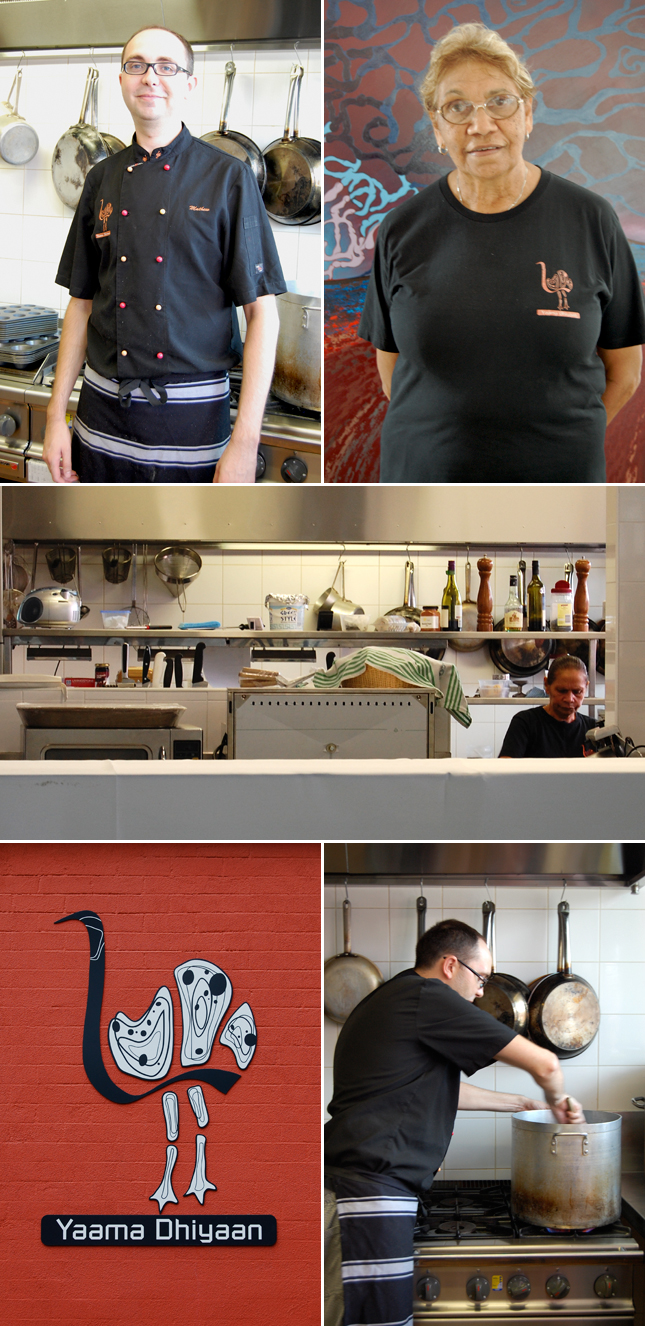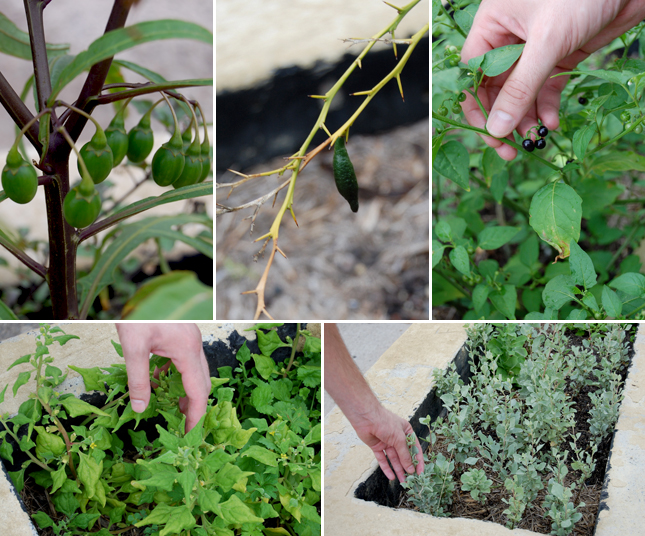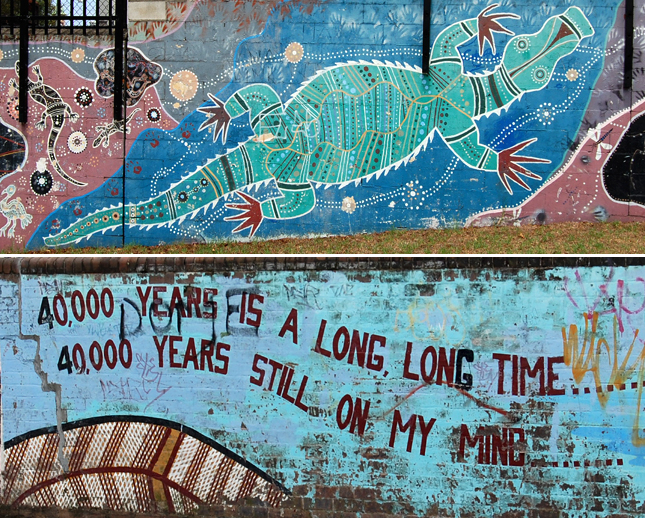Bringing Back Aboriginal Food

Undoubtedly each of the first explorers, colonists and convicts who arrived in Australia remarked on how everything seemed ineffably peculiar. One of the earliest arrivals (1688), Dutchman Dirk Hartog, wrote in his journal that: “The land is cursed; the animals hop not run, birds run not fly and the swans are black not white.” Two more elemental differences that drove colonists and convicts crazy were, the seasons are opposite and the trees lose their bark rather than their leaves.
Then there were the native people who we now call the Aboriginals to add to the colonist’s befuddlement. The arriving whites were amazed to observe that the indigenous population had no concept of ownership, no farms and only rudimentary hunting equipment. When efforts were made to finally learn some of the many Aboriginal dialects colonists were surprised to learn that there was no word in any of them for thank you. (The expression of gratitude was never necessary in a society in which there was no concept of ownership and shared what it had out of a sense of duty rather than munificence or generosity.) This nuance, like many others, was lost on most arriving settlers, among them Englishman William Dampier who said of the native population, “...they are the most miserable people in the world.” Only a few of the journal keeping colonists bothered to record in their accounts of early colonial life that had it not been for these “miserable people” and their intimate knowledge of the land, many settlers would have surely died of exposure, starvation or self-inflicted poisoning.

The Aboriginals, with their 40,000 years of experience on the continent, had amassed effective solutions to nearly all of the natural difficulties they, and the early settlers, encountered. If ever there has been a people of their land it is them. Whether it was keeping flies out of one’s eyes, ears and nose by wearing a shucked oyster on the brim of one’s hat, or in one’s hair, to finding ample forage in areas that to the uninitiated eye appeared barren, the native people demonstrated repeatedly that they were capable of doing the impossible. Such as setting off on foot into the outback, an act the whites considered a death sentence, only to return in fine health many days, weeks or months later.
The whites were just as dismayed by the local food stuffs that their Aboriginal neighbors ate. Beyond the visibly unappealing witjuti grubs and certain insects eaten by the locals the colonists turned their noses up at many of the native fruits and vegetables. Some diarists described the wild foods as “repulsive,” “dangerous” and “unpalatable.” A 19th century English botanist named J.D. Hooker, author of Flora of Tasmania, wrote that, “...although eatable not much of what grows here is fit to eat."
Until recently a dislike, even a distrust, of native foods, was the norm. For example, the sale of kangaroo meat, a delicious, plentiful, sustainable food source and one that some Aussies still refuse to eat, was legalized nationwide fairly recently in 1993. (There are approximately 40 million kangaroos in Australia, there are 22.1 million people. Kangaroos out number people nearly 2 to 1.) This distrust, however, has begun to erode and what the Aboriginals of old ate to survive has come into vogue with the resurgence of a style of foraging and preparation neatly categorized as “bushtucker.” Basically, bushtucker is food that has grown wild in the outback for centuries and was harvested by observant Aboriginals. Some items regularly found in the New South Wales and Queensland areas, where the the largest concentration of Aboriginal people can be found, are kangaroo apples, a faintly sweet fruit that contains a series of steroids of commercial value as raw material for the manufacture of contraceptives and fruits like the finger lime, kakadu plum, and the lady apple. Also common are pepperberries, now grown on plantations and used as a spice and in medicine; salt bush, a leafy green that grows in soils with high salinity and has a salty flavor and various wattle seeds from acacia trees that were gathered, ground into flour and made into bread.
As the colonization of Australia spread the decades that followed were tragic for the Aboriginal race. Families were forced to split up and children were taken from their parents and sent to schools where they were encouraged to forget their heritage. Lands, both sacred and profane were appropriated in the name of the Crown. A people whose life cycles were relegated by migration were forced to stay put. To make matters worse new diseases that the natives were not able to resistant took their toll and in less than a century the Aboriginal population, once estimated to be around 750,000 (other estimates place the figure at 315,000) had shrunk by 90%.
Disease, marginalization and unfair laws designed to deny the native’s basic rights nearly destroyed the Aboriginal culture and until recently it appeared that the knowledge amassed by generations of Aboriginals would be lost.
At the beginning of the 20th century members of the Aboriginal community organized to prevent this from happening. Though their numbers are small (an accurate Aboriginal census figure is difficult to pin down. Some sources say Aboriginals make up 2% of the total population while others claim 6%, which ever figure is accurate it is rare to see Aboriginals in mainstream life) a vocal minority began to force changes in the colonial system and protested to earn native peoples greater freedoms and equal rights. As the system began to evolve all that was left to do was undo the damage 200 years of cultural oppression. 
Two native Australians involved in this are Aunty Beryl Van-Oploo of the Kamilaroi clan and Chef Mathew Cribb of the Waradjuri. Together they run the Yaama Dhiyan Hospitality School in Sydney, Australia. The school opened in 2005 and is based in the Red Fern district of Sydney, a predominantly Aboriginal community. Red Fern, Van-Oploo explains, “...has always been our meeting place for as long as I can remember.” The nine week program is offered four times a year and teaches courses in cooking and hospitality service training with an emphasis on native cuisine and Aboriginal cultural programs. “We open the program to 20 people and then we allow for drop outs,” says Van-Oploo, “If we can graduate 15 or 16 then we’re happy. At the end of the day the focus is to put people in a job. It’s like a stepping stone. It’s been a long time coming for Aboriginal people. The school has got a good feel about it and we’re getting outcomes, that’s the main thing. My three words are communication, education and respect. With those three things and it’ll happen for everybody.”
At the completion of the nine weeks students earn three certificates that will enable them to to find work in the hospitality industry. In the five years of its existence Yamma, which means ‘welcome,’ Dhiyan, which means ‘family’ or ‘friends’ in Aboriginal, have formed relationships with large local companies, among them Qantas, and place 80% of their students in jobs. Many others have gone onto to further their studies in either hospitality or the culinary arts. “It’s been really good,” says Van-Oploo, “some of our students are as young as 15 and I’d rather see them here than be on the streets doing nothing. Then, hopefully I can get them back in school or into a trade. You know, if they go into a trade so be it. A lot of Aboriginal people like doing things with their hands.”
Australia’s first and only hospitality college specializing in indigenous culture and cuisine has been one of Van-Oploo’s goals since becoming an educator. “This has been a dream of mine for over thirty years,” explains Mrs. Van-Oploo, “it just didn’t happen over night. It’s been about getting out there and having a go and showing that we can do these things. And when you haven’t been given a go, like when I was eighteen I didn’t have any rights and Aboriginal people weren’t allowed to own anything until 1969. If we were given the chance to have our own land and our own collateral then we wouldn’t be in this situation. You don’t forget your past but you move on to make a better future for your children and your grand children.”
On our visit to Yamma Dhiyaan Mathew Cribb cooked us a fabulous kangaroo pie - not quite an Aboriginal recipe but a nice combination of cultures and ingredients. His recipe follows.
Chef Mathew Cribb’s Drunken Kangaroo Pie
If kangaroo meat in unavailable elk makes a wonderful substitute - they both are lean and rich with a faint gaminess. A lean cut of beef would also work but may lack some character.
1/2 onion, diced into 1/2” pieces
1 carrot, diced into 1/2” pieces
2 stalks celery, diced into 1/2” pieces
1.3 pounds (600 grams) kangaroo rump meat, cut into 1/2” pieces
2-12 ounce bottles of ale
2 pints (1 liter) water
pie dough (short crust) enough for top and bottom of standard pie
puff pastry
1 egg
2 tablespoons canola or other oil suitable for high heat
salt & pepper to taste
Heat a stock pot over medium. Add oil and vegetables. Sauté until soft. Add meat and brown on all sides. Deglaze the pot with beer then add water. Cover and simmer for 1 to 1.5 hours or until meat is tender. While meat braises brush a pie dish or cupcake tins with oil then line with pie crust. Season the meat with salt & pepper to taste and allow it to cool thoroughly, then place in prepared dough. Cover with puff pastry. Prepare an egg wash by scrambling egg. Brush egg wash on top puff pastry crust and seal with fingers. Bake at 350°F (180°C) for 45 minutes to 1 hour or until crust is golden brown and flaky. Allow to cool for a few minutes then serve and enjoy immediately.
Contact Information:
Yaama Dhiyaan Hospitality Training College
255 Wilson Street
Darlington, NSW
2008
T: 02 8399 0924






 Share Article
Share Article
Reader Comments (5)
-- Hey there OysterCulture - Elk or bison are perfect substitutes for kangaroo. They taste so similar - all 3 are very lean while still being dark and rich.
Thank you for this educational and inspiring post (taking advantage of the fact that this word exists in English :-) ).
I had no idea at the time (no idea until right now) that it had been illegal to eat kangaroo meat!
Great story, great pix!
"...all that was left to do was undo the damage 200 years of cultural oppression." Yeah, that's all!
The story of the Aborigines and their interaction with Europeans has been a tragic one, but with people like Beryl Van-Oploo on the scene, at least there is hope.